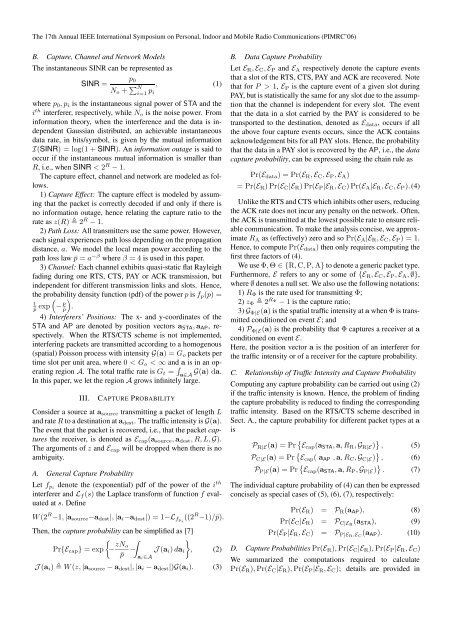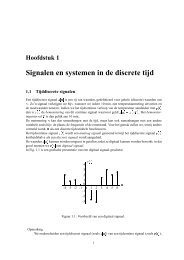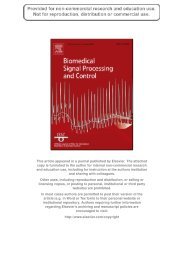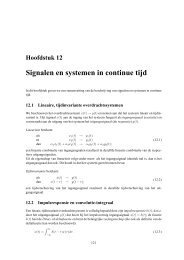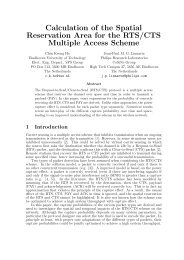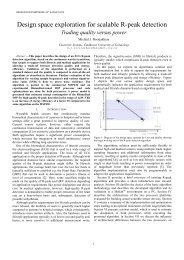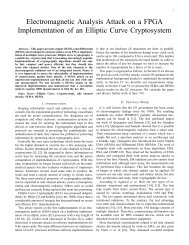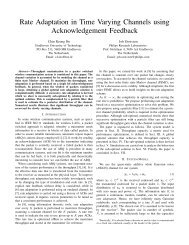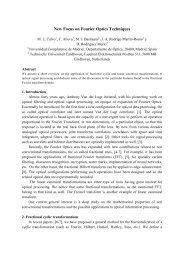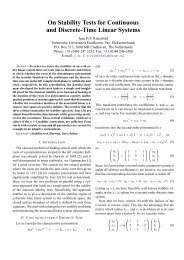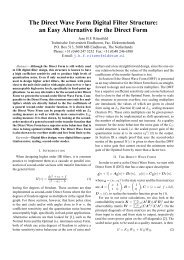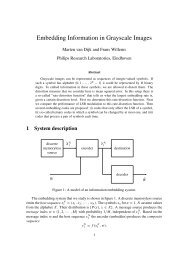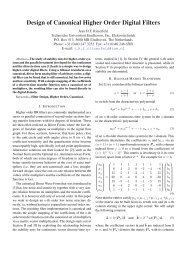analysis of the rts/cts multiple access scheme with capture effect
analysis of the rts/cts multiple access scheme with capture effect
analysis of the rts/cts multiple access scheme with capture effect
Create successful ePaper yourself
Turn your PDF publications into a flip-book with our unique Google optimized e-Paper software.
The 17th Annual IEEE International Symposium on Personal, Indoor and Mobile Radio Communications (PIMRC’06)<br />
B. Capture, Channel and Network Models<br />
The instantaneous SINR can be represented as<br />
p 0<br />
SINR =<br />
N o + ∑ N<br />
i=1 p , (1)<br />
i<br />
where p 0 , p i is <strong>the</strong> instantaneous signal power <strong>of</strong> STA and <strong>the</strong><br />
i th interferer, respectively, while N o is <strong>the</strong> noise power. From<br />
information <strong>the</strong>ory, when <strong>the</strong> interference and <strong>the</strong> data is independent<br />
Gaussian distributed, an achievable instantaneous<br />
data rate, in bits/symbol, is given by <strong>the</strong> mutual information<br />
I(SINR) = log(1 + SINR). An information outage is said to<br />
occur if <strong>the</strong> instantaneous mutual information is smaller than<br />
R, i.e., when SINR < 2 R − 1.<br />
The <strong>capture</strong> <strong>effect</strong>, channel and network are modeled as follows.<br />
1) Capture Effect: The <strong>capture</strong> <strong>effect</strong> is modeled by assuming<br />
that <strong>the</strong> packet is correctly decoded if and only if <strong>the</strong>re is<br />
no information outage, hence relating <strong>the</strong> <strong>capture</strong> ratio to <strong>the</strong><br />
rate as z(R) 2 R − 1.<br />
2) Path Loss: All transmitters use <strong>the</strong> same power. However,<br />
each signal experiences path loss depending on <strong>the</strong> propagation<br />
distance, a. We model <strong>the</strong> local mean power according to <strong>the</strong><br />
path loss law ¯p = a −β where β = 4 is used in this paper.<br />
3) Channel: Each channel exhibits quasi-static flat Rayleigh<br />
fading during one RTS, CTS, PAY or ACK transmission, but<br />
independent for different transmission links and slots. Hence,<br />
<strong>the</strong> probability density function (pdf) <strong>of</strong> <strong>the</strong> power p is f p (p) =<br />
1<br />
¯p exp (− p¯p<br />
)<br />
.<br />
4) Interferers’ Positions: The x- and y-coordinates <strong>of</strong> <strong>the</strong><br />
STA and AP are denoted by position vectors a STA , a AP , respectively.<br />
When <strong>the</strong> RTS/CTS <strong>scheme</strong> is not implemented,<br />
interfering packets are transmitted according to a homogenous<br />
(spatial) Poisson process <strong>with</strong> intensity G(a) = G o packets per<br />
time slot per unit area, where 0 < G o < ∞ and a is in an operating<br />
region A. The total traffic rate is G t = ∫ G(a) da.<br />
a∈A<br />
In this paper, we let <strong>the</strong> region A grows infinitely large.<br />
III.<br />
CAPTURE PROBABILITY<br />
Consider a source at a source transmitting a packet <strong>of</strong> length L<br />
and rate R to a destination at a dest . The traffic intensity is G(a).<br />
The event that <strong>the</strong> packet is recovered, i.e., that <strong>the</strong> packet <strong>capture</strong>s<br />
<strong>the</strong> receiver, is denoted as E cap (a source , a dest , R, L, G).<br />
The arguments <strong>of</strong> z and E cap will be dropped when <strong>the</strong>re is no<br />
ambiguity.<br />
A. General Capture Probability<br />
Let f pi denote <strong>the</strong> (exponential) pdf <strong>of</strong> <strong>the</strong> power <strong>of</strong> <strong>the</strong> i th<br />
interferer and L f (s) <strong>the</strong> Laplace transform <strong>of</strong> function f evaluated<br />
at s. Define<br />
W (2 R −1, |a source −a dest |, |a i −a dest |) = 1−L fpi ((2 R −1)/¯p).<br />
Then, <strong>the</strong> <strong>capture</strong> probability can be simplified as [7]<br />
{<br />
Pr{E cap } = exp − zN o<br />
¯p<br />
∫a − J (a i ) da i<br />
}, (2)<br />
i∈A<br />
J (a i ) W (z, |a source − a dest |, |a i − a dest |)G(a i ). (3)<br />
B. Data Capture Probability<br />
Let E R , E C , E P and E A respectively denote <strong>the</strong> <strong>capture</strong> events<br />
that a slot <strong>of</strong> <strong>the</strong> RTS, CTS, PAY and ACK are recovered. Note<br />
that for P > 1, E P is <strong>the</strong> <strong>capture</strong> event <strong>of</strong> a given slot during<br />
PAY, but is statistically <strong>the</strong> same for any slot due to <strong>the</strong> assumption<br />
that <strong>the</strong> channel is independent for every slot. The event<br />
that <strong>the</strong> data in a slot carried by <strong>the</strong> PAY is considered to be<br />
transported to <strong>the</strong> destination, denoted as E data , occurs if all<br />
<strong>the</strong> above four <strong>capture</strong> events occurs, since <strong>the</strong> ACK contains<br />
acknowledgement bits for all PAY slots. Hence, <strong>the</strong> probability<br />
that <strong>the</strong> data in a PAY slot is recovered by <strong>the</strong> AP, i.e., <strong>the</strong> data<br />
<strong>capture</strong> probability, can be expressed using <strong>the</strong> chain rule as<br />
Pr(E data ) = Pr(E R , E C , E P , E A )<br />
= Pr(E R ) Pr(E C |E R ) Pr(E P |E R , E C ) Pr(E A |E R , E C , E P ).(4)<br />
Unlike <strong>the</strong> RTS and CTS which inhibits o<strong>the</strong>r users, reducing<br />
<strong>the</strong> ACK rate does not incur any penalty on <strong>the</strong> network. Often,<br />
<strong>the</strong> ACK is transmitted at <strong>the</strong> lowest possible rate to ensure reliable<br />
communication. To make <strong>the</strong> <strong>analysis</strong> concise, we approximate<br />
R A as (<strong>effect</strong>ively) zero and so Pr(E A |E R , E C , E P ) = 1.<br />
Hence, to compute Pr(E data ) <strong>the</strong>n only requires computing <strong>the</strong><br />
first three factors <strong>of</strong> (4).<br />
We use Φ, Θ ∈ {R, C, P, A} to denote a generic packet type.<br />
Fur<strong>the</strong>rmore, E refers to any or some <strong>of</strong> {E R , E C , E P , E A , ∅},<br />
where ∅ denotes a null set. We also use <strong>the</strong> following notations:<br />
1) R Φ is <strong>the</strong> rate used for transmitting Φ;<br />
2) z Φ 2 RΦ − 1 is <strong>the</strong> <strong>capture</strong> ratio;<br />
3) G Φ|E (a) is <strong>the</strong> spatial traffic intensity at a when Φ is transmitted<br />
conditioned on event E; and<br />
4) P Φ|E (a) is <strong>the</strong> probability that Φ <strong>capture</strong>s a receiver at a<br />
conditioned on event E.<br />
Here, <strong>the</strong> position vector a is <strong>the</strong> position <strong>of</strong> an interferer for<br />
<strong>the</strong> traffic intensity or <strong>of</strong> a receiver for <strong>the</strong> <strong>capture</strong> probability.<br />
C. Relationship <strong>of</strong> Traffic Intensity and Capture Probability<br />
Computing any <strong>capture</strong> probability can be carried out using (2)<br />
if <strong>the</strong> traffic intensity is known. Hence, <strong>the</strong> problem <strong>of</strong> finding<br />
<strong>the</strong> <strong>capture</strong> probability is reduced to finding <strong>the</strong> corresponding<br />
traffic intensity. Based on <strong>the</strong> RTS/CTS <strong>scheme</strong> described in<br />
Sect. A., <strong>the</strong> <strong>capture</strong> probability for different packet types at a<br />
is<br />
P R|E (a) = Pr { E cap (a STA , a, R R , G R|E ) } , (5)<br />
P C|E (a) = Pr { E cap ( a AP , a, R C , G C|E ) } , (6)<br />
P P|E (a) = Pr { E cap (a STA , a, R P , G P|E ) } . (7)<br />
The individual <strong>capture</strong> probability <strong>of</strong> (4) can <strong>the</strong>n be expressed<br />
concisely as special cases <strong>of</strong> (5), (6), (7), respectively:<br />
Pr(E R ) = P R (a AP ), (8)<br />
Pr(E C |E R ) = P C|ER (a STA ), (9)<br />
Pr(E P |E R , E C ) = P P|ER,E C<br />
(a AP ). (10)<br />
D. Capture Probabilities Pr(E R ), Pr(E C |E R ), Pr(E P |E R , E C )<br />
We summarized <strong>the</strong> computations required to calculate<br />
Pr(E R ), Pr(E C |E R ), Pr(E P |E R , E C ); details are provided in


